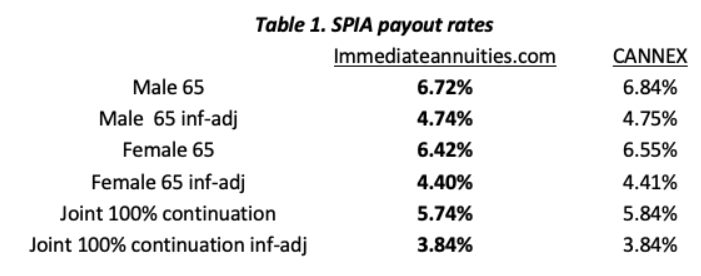 Annuities have a rather mixed reputation, which I think is mostly deserved. Some are amazingly complex and expensive (the word “Indexed” can be bad in this world). Then there are simple, straightforward ones that are worth consideration, including single premium immediate annuities (SPIA). The most basic version lets you convert a lump-sum payment into a regular stream of income payments that is guaranteed and doesn’t ever vary, period.
Annuities have a rather mixed reputation, which I think is mostly deserved. Some are amazingly complex and expensive (the word “Indexed” can be bad in this world). Then there are simple, straightforward ones that are worth consideration, including single premium immediate annuities (SPIA). The most basic version lets you convert a lump-sum payment into a regular stream of income payments that is guaranteed and doesn’t ever vary, period.
Michael Edesess has an article . The article is on a site meant for financial advisors, so it’s got a lot of jargon inside. However, I do like that it provided some hard numbers to consider.
Here are current market rates:

In other words, a 65-year-old male hands over $100,000 and will get $6,720 per year ($560 per month), every year, for the rest of his life. Putting up $1,000,000 will get you $67,200 per year ($5,600 per month). Whether he lives to 68 or 108, he will end up with zero dollars. A female would get a bit less due to a longer average lifespan, and a joint annuity even less than that as the likelihood of at least one person living a long time is higher.
The article then compared the annuity payout against the “safe withdrawal rate” as calculated by popular industry methods. The Bengen method has a fixed payout percentage every month, adjusted annually for inflation. The HWS strategy uses a variable payout with a floor rate and allows a higher payout if the portfolio has high returns. I’ll just share one of them.

As you can see, the immediate annuity offers a higher annual payout in almost all cases. This is good.
However, you are giving up certain things in exchange for this higher income. Once you die, there is nothing left for heirs or charity. Thus, part of your return is simply them giving your own money back to you (return of principal). You have lost permanent control of that money, with no liquidity if for any reason you had a big expense. Finally, unless you buy a special inflation-adjusted annuity with a much lower initial payout, your monthly payment will buy less and less as inflation eats away at it over time.
I would also read about your applicable and always stay under them. It is rare for an insurance company to fail, but it has happened. Read about the . The state guaranty association system is not as good as FDIC insurance, but being within the limits is much better than being above the limits!
Bottom line. I would research single-premium immediate annuities as a source of retirement income once your reach age 59.5. I would avoid any annuity that is linked or “indexed” to the stock market. Personally, I am thinking of annuitizing a fraction of my portfolio (less than 10%) once I reach a certain age, but only if it remains under state guaranty limits.
“The editorial content here is not provided by any of the companies mentioned, and has not been reviewed, approved or otherwise endorsed by any of these entities. Opinions expressed here are the author’s alone. This email may contain links through which we are compensated when you click on or are approved for offers.”
from .
Copyright © 2018 MyMoneyBlog.com. All Rights Reserved. Do not re-syndicate without permission.